These eight states together have 3.8% of India’s population, but they currently account for 14% of daily cases. The number of active cases in these states went up to 55,033 on 28 July, from 49,455 on 21 July. Cases grew in four of these eight states, with the exceptions being Arunachal Pradesh, Assam, Nagaland and Tripura. Mizoram, which has relatively high vaccination coverage is the worst affected, and saw the number of active cases go up by 1.6 times. Currently, it has 10,500 active cases, as opposed to last week’s 6,571.
Of the 22 districts across India that have seen their daily new cases go up in each of the last 4 weeks, 13 belonged to six north-eastern states, government data shows. In Imphal East in Manipur, new cases have risen in each of the past 6 weeks. This week, it reported 1,927 new cases, up from 907 in the first week of July.
Crucially, 48 out of 57 districts in the north-east for which data is available have registered a daily test positivity rate (TPR) higher than the national average in the past seven days. Of these, 36 districts have a TPR of over 5%. A TPR below 5% is an indicator that the disease is under control. TPRs of Mizoram, Manipur and Sikkim are higher than Kerala’s 12%. Imphal East and Thoubal’s seven-day TPR stand at 30.8% and 22.7%, respectively.
Viral Hotspots
North-eastern states also account for a significant share of deaths. Of the 18 districts that have seen a rise in deaths in each of the last two weeks, 9 were from the north-east. East Khasi Hills in Meghalaya saw a 49% increase in the number of deaths in the last week, on top of a 65% increase in the week before. The number of deaths picked up pace in some other districts as well. In Golaghat in Assam and Kangpokpi in Manipur, the number of deaths jumped by 63% and 40% respectively, from 10% and 25% in the previous week.
Nationally though, the number of deaths came down by 50% to 3,674 this week from 7,002 last week, though last week’s count was higher because of a one-off reconciliation by Maharashtra. Beyond north-eastern states, there are also pockets of concern. Khordha in Odisha registered a 8.6% increase in deaths to 164, the highest among all districts. This comes on the top of 57.3% increase in the week before. Deaths in Kerala again witnessed a growth of 23.5%, after reporting a decline last week.
Gathering Pace
In the past seven days, India has accelerated its pace of vaccination. It averaged 4.7 million doses per day, up from 3.8 million doses in the week before that. So far, 26% of the population, or 352 million have been vaccinated with at least one dose. Among states with over 5 million population, Himachal Pradesh continues to lead in vaccine coverage, having given 680 doses per 1,000 people. Kerala (533), Delhi (526), and Gujarat (504) follow.
The eight north-eastern states average 524 doses per 1,000 population. On one hand, Sikkim and Tripura have given 918 and 738 doses. On the other, Manipur, Nagaland, Meghalaya and Assam have each given less than 450 doses. The three most populated districts in this region — Nagaon, Cachar and Barpeta, all from Assam — have each given less than 250 doses per 1,000 people.
China Leading
Globally, India maintained its fourth spot in vaccine coverage among the 10 most-populous countries for the fourth straight week. This week, it registered a 6.8% week-on-week growth in its share of population that has received at least one dose of the covid-19 vaccine.
Meanwhile, China continued to make huge strides in mass vaccination, having administered 15.8 billion doses, 40% of the total vaccines given globally, according to data available on Our World in Data. With the Tokyo Olympics beginning last week, the pace of vaccination in Japan has further reduced. This week, it registered a growth of only 5.6% in coverage, as opposed to 26% in the first week of this month.
The stated aim of the Indian government was to administer 500 million doses by July, which is likely to be missed. Unless the pace of vaccination goes up here on, the government will miss the year-end target of vaccinating all adults as well.



